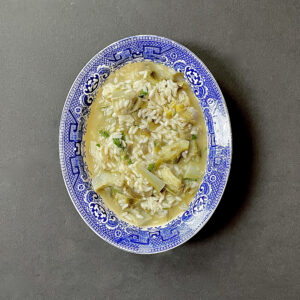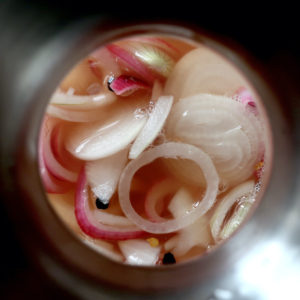Artichoke Caponata
It is weird to admit you miss people you’ve never met, but I do. That chef Judy Rodgers no longer walks the earth frequently pains me. Fortunately, she left us with a single, perfect work, the Zuni Café Cookbook.
The Zuni Café Cookbook, together with Paula Wolfert’s The Cooking Of Southwest France, made me the cook I am today. I know I often say so, but these books took me from being a decent cook to somebody who understands herself in the kitchen. Notice I do not say “great cook.” That comes with time and practice. But Rodgers was a born teacher, able to convey her expertise with passion, warmth, and clarity.

This artichoke caponata crops up in variant formats across the Chez Panisse oeuvre: David Tanis offers an artichoke antipasto in his book of nearly the same title; another appears in One Good Dish. David Lebovitz, writing in My Paris Kitchen, chimes in with Artichoke Tapenade in Rosemary Oil. Paul Bertolli pairs artichokes stewed in olive oil with sea bass in Chez Panisse Cooking. These recipes are relatives, their ingredients a call-and-response from the Mothership Alice: olive oil and garlic, lemon and salt. Everyone includes a punchy element: olives, capers, both. There’s vinegar’s acidic bite, or David Tanis’s “small glass of white wine.” Perhaps a bit of cayenne, or minced rosemary, oregano or marjoram or mint. Maybe just chopped parsley. Even Tamar Adler, in the midst of her Everlasting Meal poetics, tosses out an artichoke recipe speaking purely of Chez Panisse:
Put them in a pot in a combination of water and olive oil, a sprinkle of white wine, a single bay leaf, a very big pinch of salt, and a few sprigs of fresh thyme. Simmer them until they’re completely tender.
Of course, there are the artichokes themselves. Canned or frozen won’t do, as they’re either already marinated, or treated with ascorbic acid. Fresh is the name of the game, fresh and as small as you can find them; preferably those marketed as “baby,” too small to have formed chokes, therefore costing more.

If no small artichokes are to be had, buy medium ones. So long as you avoid artichokes the size of your skull, the recipe will work.
This brings us to the general anxiety surrounding artichokes. Namely, many people have no idea how to handle them. There’s also concern about needing lemons to prevent darkening and which knives or pots to use. As this recipe requires long cooking, it does away with the kerfluffle. Use stainless steel or enameled cast iron. Avoid cheap aluminum. Any oxidation–that is, vegetable darkening–will vanish during cooking.
This is an old-fashioned recipe, the kind requiring time to prepare and a waiting period while the caponata mellows. This is not instant food.
Artichoke caponata begins beautifully, with baby artichokes resplendent in all their Fibonacci glory, accompanied by fresh celery and brick red tomato paste.

Matters grow progressively greyer with every step, the end result looking, Rodgers writes, like “dryish vegetable chutney.”

Prep times are elusive. I don’t know how big your artichokes are or how quickly you peel them. While this recipe won’t take all afternoon, nor is it a 15-minute special. The artichokes need to be fully cooked, which could take 10 minutes or an hour. Trust me: undercooked artichokes make for chalky, unpleasant eating.
A final note: Rodgers uses more sugar in her recipe, making an authentic agrocdulce–sweet-sour–dish. I prefer less sugar. Let taste be your guide; the original recipe adds up to 2 tablespoons.

Artichoke Caponata
Adapted from The Zuni Café Cookbook by Judy Rodgers
yield: about 2 cups
Prep time: this depends on the size of your artichokes and how quickly you prep them. Cooking can take up to an hour, with a 2-5 day mellowing time.
approximately 2-2 1/2 pounds baby artichokes, or the smallest fresh artichokes you can find
(about 16)
1/4 cup tomato paste
1 teaspoon sugar (see notes)
1/2 cup Champagne or white wine vinegar
1/2 cup olive oil (you may not use it all)
2/3 cup chopped celery
2/3 cup sliced onion
2-3 cloves garlic, peeled and minced
3 tablespoons capers, rinsed and lightly chopped
salt
Place a 3-4 quart lidded saucepan on the lowest flame. Stir together the tomato paste, sugar, and vinegar.
Place a 12-inch stainless steel skillet (not cast iron or aluminum) on medium heat. Add one tablespoon olive oil from the 1/2 cup measure. Sauté the celery, stirring, for a few minutes, until it softens and colors just bit. Add it to the tomato-vinegar mixture.
Add more olive oil to the pan if necessary, then add the onions. Cook, but don’t fry them. You want them to soften and become translucent. Cook for about 4 minutes. A little bit of color is okay. If they begin browning and crisping up, turn the heat down. Add them to the tomato-vinegar-celery mixture. Salt it lightly, stir, and turn the heat off. Cover.
Turn heat off under skillet.
Turn to the artichokes:
In terms of prep for this recipe, they do not need to be acidulated, that is, rubbed with lemon, because the cooking will take care of any darkening. They will darken, and start looking gungy. Don’t worry.
To prep:
–break off the outside rough leaves until you reach the inner, pale green leaves. You’ll notice the artichoke tapering to a tip. Slice the top portion of the cone off, about halfway down.
–using a paring knife or vegetable peeler, pare the stem and cone of small leaves and hard bits.
–depending on size, slice artichoke in half or quarters. If there’s a fuzzy choke surrounded by sharp leaves, pry out using a melon baller or sharp spoon, like an iced tea spoon. Leave the “meaty” part–that’s the heart, a delicacy. The stems are an extension of the heart, edible and delicious.
Once the artichokes are all peeled, add a little more olive oil to the skillet if necessary; you want about two tablespoons in there. Turn the heat to medium. Add the artichokes. Stir them in the oil, then allow them to take color a few minutes. Turn them, and let them take color again. I do this a couple times.
Reduce the heat to low, cover the pan, and cook artichokes for another 5 minutes.
Add artichokes to tomato-vegetable mixture. Stir over medium heat. Taste for salt and sugar, remembering you are about to add capers. Mixture will be very dry; add a little water if it’s too dry.
Stir with a wooden spoon until caponata reaches a gentle bubble. Add the capers, cover, and turn the heat down to medium low. Cook gently, until artichokes are cooked through. They should be tender enough to cut with a wooden spoon. Depending on the size of your artichokes, this can take 30 minutes to an hour.
The artichokes may taste quite acidic right out of the pot. They will mellow after 2-5 days.
Store in a covered, refrigerated container 2-5 days. Serve as an antipasto with cured meats, olives, radishes, and cheeses, or eat it as I do, in a sandwich with ricotta cheese.
This will keep well due to vinegar content, but is best within 7 days.
Notes:
The original recipe calls for up to 2 tablespoons sugar. Add to taste.

(serving suggestion. not shown: curious feline.)




